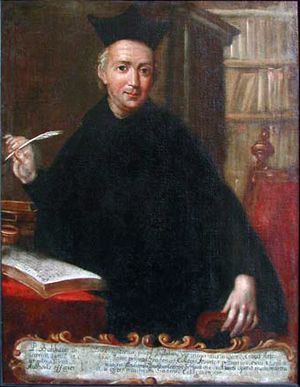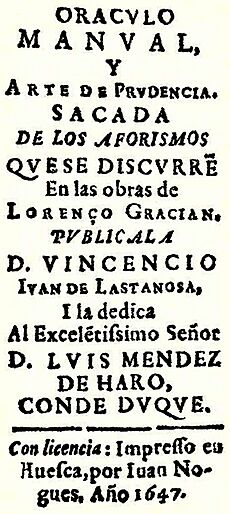Baltasar Gracián facts for kids
Quick facts for kids
The Reverend
Baltasar Gracián
SJ
|
|
|---|---|

Baltasar Gracián
|
|
| Born | 8 January 1601 |
| Died | 6 December 1658 (aged 57) Tarazona, Aragón, Spanish Empire
|
| Era | 17th-century philosophy |
| Region | Western Philosophy |
| School | Spanish Baroque literature, Christian philosophy |
|
Main interests
|
Political philosophy, moral philosophy |
Baltasar Gracián (born January 8, 1601 – died December 6, 1658) was a Spanish writer and thinker. He was a Jesuit, which is a member of a Catholic religious order. Gracián lived during the Baroque period, a time known for its fancy and detailed art and literature.
He was born in a town called Belmonte, near Calatayud in Aragón, Spain. Gracián became famous for his deep ideas and his unique writing style. Even famous philosophers like Arthur Schopenhauer and Friedrich Nietzsche admired his work.
Contents
A Jesuit's Life
Baltasar Gracián was the son of a doctor. When he was a child, he lived with his uncle, who was a priest. He went to a Jesuit school to study and later studied theology (the study of religious faith) in Zaragoza.
He became a priest in 1627. In 1633, he officially joined the Jesuits. He spent his time teaching in different Jesuit schools. He lived in Huesca, where he became good friends with a local scholar named Vincencio Juan de Lastanosa. This friendship helped Gracián grow as a thinker.
Gracián was also known as a good preacher. However, some of his sermons were a bit unusual. For example, he once read a letter that he said came from Hell! His bosses didn't like this very much.
He became the leader (Rector) of the Jesuit College in Tarragona. During this time, he wrote books about how people should act in important positions. These books included El héroe (The Hero) and El político (The Politician). He also worked as a chaplain (a priest for the army) during a war in Spain.
Writing and Challenges
In 1651, Gracián published the first part of his most famous book, El Criticón. He did this without getting permission from his Jesuit leaders. This made them very unhappy. Even after being told off, he published the second part of Criticón in 1657.
Because he kept disobeying, he was punished. He was sent away to a place called Graus in 1658. Gracián even tried to join a different religious group, but his request was not accepted. His punishment was made a bit lighter, and he was given smaller jobs in Tarazona.
Gracián's health got worse, and he died on December 6, 1658, in Tarazona. The village where he was born, Belmonte, later changed its name to Belmonte de Gracián in his honor.
Gracián's Writing Style
Gracián is famous for a Spanish writing style called Conceptismo. This style uses clever ideas and tries to say a lot with very few words. It's like solving a puzzle with words. He used many different writing tricks to make his sentences interesting.
His book Agudeza y arte de ingenio (Wit and the Art of Inventiveness) explains this style. It's like a guide for how to write in a witty and clever way.
El Criticón
El Criticón is Gracián's most important work. It was published in three parts between 1651 and 1657. This book became very popular in Europe, especially in Germany. It is considered one of the greatest works from Spain's Siglo de Oro (Golden Age).
The book is a long story with a hidden meaning, like a fable. It follows two main characters on a long journey through life:
- Critilo: He is the "critical man" who has seen a lot of the world and is often disappointed.
- Andrenio: He is the "natural man" who grew up without knowing much about civilization.
Together, they travel to the "Isle of Immortality." Along the way, they meet many different people and face challenges. The story shows a somewhat sad view of the world, which was liked by the German philosopher Arthur Schopenhauer.
Here's a quick look at their journey:
- Part One: "In the Spring of Childhood." They visit a royal court and are disappointed by what they see.
- Part Two: "In the Autumn of the Age of Manliness." They travel through Spain and France. Gracián calls France a "wasteland" full of fake and foolish people. They even visit a house for people who are not well.
- Part Three: "In the Winter of Old Age." They arrive in Rome and finally reach the "Isle of Immortality."
Gracián was a very smart writer who shared many wise thoughts. One of his famous sayings is: "Respect yourself if you would have others respect you."
The Art of Worldly Wisdom
Another important book by Gracián is El Oráculo Manual y Arte de Prudencia, often called The Art of Worldly Wisdom. This book is made up of 300 short sayings or "maxims" with comments. Each maxim gives practical advice on how to live well and succeed in a complicated world.
This book has been popular for a long time. In 1992, a new English translation of it became a bestseller in the United States. It sold almost 200,000 copies! Many famous people have read and admired Gracián's work. For example, it is believed that Winston Churchill, a famous British leader, read an English translation of this book.
What People Thought of Gracián
Many important thinkers have praised Baltasar Gracián.
- The famous German philosopher Arthur Schopenhauer loved Gracián's work so much that he translated it into German. He called The Art of Worldly Wisdom "Absolutely unique... a book made for constant use... a companion for life."
- Another German philosopher, Friedrich Nietzsche, said that Gracián's book El Discreto was "Europe has never produced anything finer or more complicated in matters of moral subtlety."
Gracián's ideas have been translated into many languages, including Finnish, Portuguese, Chinese, Japanese, and Korean.
Gracián's Main Works
Here are some of Baltasar Gracián's important books:
- El Héroe (1637, The Hero): This book describes what an ideal Christian leader should be like.
- El Político Don Fernando el Católico (1640, The Politician King Ferdinand the Catholic): This book shows the perfect image of a king.
- El Arte de Ingenio (1642, The Art of Ingenuity): This book is about literature and how to write cleverly.
- El Discreto (1646, The Discreet One): This book talks about the qualities that make a person complete and perfect.
- El Oráculo Manual y Arte de Prudencia (1647, The Art of Worldly Wisdom): A collection of 300 wise sayings with advice for life.
- El Comulgatorio (1655): A religious book with prayers and thoughts for Holy Communion.
- El Criticón (1651–1657): His most famous novel, a three-part story about a journey through life.
It's interesting to know that most of Gracián's important books were not published under his real name. He often used the name Lorenzo Gracián (who was supposedly his brother) or an anagram (a rearranged name) like Gracía de Marlones. He was punished for publishing El Criticón without permission, but his ideas themselves were not criticized.
See also
 In Spanish: Baltasar Gracián para niños
In Spanish: Baltasar Gracián para niños


